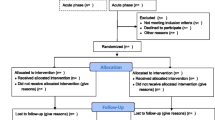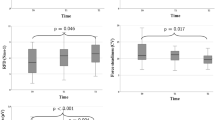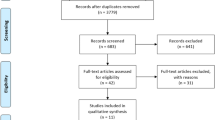Abstract
Aerobic exercise training is used for rehabilitation in patients with chronic obstructive pulmonary disease (COPD), although it has little effect on muscle weakness and atrophy. Resistance training may be a useful addition to aerobic programs for these patients. The purpose of the present study was to investigate the effects of resistance training in addition to aerobic training on functional outcomes in patients with COPD. Seventeen COPD patients enrolled in an aerobic-based program that met twice a week were assigned to a 12-week control/aerobic [CON: n=8; 63 (8) years; mean (SD)] or a resistance/aerobic group [RES: n=9; 61 (7) years]. RES trained an additional twice a week on 12 resistance machines, performing three sets of 8–12 repetitions at 32–64% of their one-repetition maximum (1-RM) lifts. RES (P<0.05) increased upper (36%) and lower (36%) body strength, as well as lean body mass (5%), while CON showed little to no change. The 12-min walk distance increased (P<0.05) in only the RES [676 (219) to 875 (172) m]. Measurements of three of the eight tasks of activities of daily living improved in RES (P<0.05) compared to CON. This study demonstrated that progressive resistance training was well tolerated and improved functional outcomes in COPD patients that were currently involved in an aerobic training program.
Similar content being viewed by others
References
American Association of Cardiovascular and Pulmonary Rehabilitation (1995) Guidelines for Cardiac Rehabilitation Programs, 2nd edn. Human Kinetics, Champaign, Ill., pp 27–56
American Thoracic Society (1995) Statement. Standards for the diagnosis and care of patients with chronic obstructive pulmonary disease. Am J Respir Crit Care Med 160:1666–1682
Bernard S, LeBlanc P, Whittom F (1998) Peripheral muscle weakness in patients with chronic obstructive pulmonary disease. Am J Respir Crit Care Med 157:1489–1497
Bernard S, Whittom F, LeBlanc P, Jobin J, Belleau R, Berube C, Carrier G, Maltais F (1999) Aerobic and strength training in patients with chronic obstructive pulmonary disease. Am J Respir Crit Care Med 159:896–901
Borg G (1982) Psychophysical bases of perceived exertion. Med Sci Sports Exerc 14:377–381
Brown WJ, Meshra G, Lee C, Bauman A (2000) Leisure time physical activity in Australian women: relationship with well-being and symptoms. Res Q Exerc Sport 71:206–218
Buchner DM, Larson EB, Wagner EH, Koepsell TD, Lateur BJ de (1996) Evidence for a non-linear relationship between leg strength and gait speed. Age Aging 25:386–391
Casaburi R (2001) Skeletal muscle dysfunction in chronic obstructive pulmonary disease. Med Sci Sports Exerc 33:S662–S670
Casaburi R, Patessio J, Ioli F, Zanaboni S, Donner CF, Wasserman K (1991) Reduction in exercise lactic acidosis and ventilation as a result of exercise training in obstructive lung disease. Am Rev Respir Dis 143:9–18
Casaburi R, Porszasz J, Burns MR, Carithers RS, Chang RSY, Cooper CB (1997) Physiological benefits of exercise training in rehabilitation of patients with severe chronic obstructive pulmonary disease. Am J Respir Crit Care Med 155:1541–1551
Chandler JM, Duncan PW, Kochersberger G (1998) Is lower extremity strength gain associated with improvement in physical performance and disability in frail, community-dwelling elders? Arch Phys Med Rehabil 79:24–30
Clark CJ, Cochrane L, Mackay E (1996) Low intensity peripheral muscle conditioning improves exercise tolerance and breathlessness in COPD. Eur Respir J 9:2590–2596
Clark CJ, Cochrane LM, Mackay E, Paton B (2000) Skeletal muscle strength and endurance in patients with mild COPD and the effects of weight training. Eur Respir J 15:92–97
Cooper CB (2001) Exercise in chronic pulmonary disease: limitations and rehabilitation. Med Sci Sports Exerc 33:S643–S646
Cress ME, MeyerM (2003) Maximal voluntary and functional performance levels needed for independence in adults aged 65 to 97 years. Phys Ther 83:37–47
Cress ME, Buchner DM, Questad KA, Esselman PC, Lateur BJ de, Schwartz RS (1996) Continuous-scale physical functional performance in healthy older adults: a validation study. Arch Phys Med Rehabil 77:1243–1250
Cress ME, Buchner DM, Questad KA, Esselman PC, Lateur BJ de, Schwartz RS (1999) Exercise: effects on physical functional performance in independent older adults. J Gerontol 54A:M242–M248
Cureton KJ, Collins MA, Hill DW, McElhannon FM (1988) Muscle hypertrophy in men and women. Med Sci Sports Exerc 20:338–344
Engelen MP, Schols AM, Heidendal GA, Wouters EF (1998) Dual-energy X-ray absorptiometry in the clinical evaluation of body composition and bone mineral density in patients with chronic obstructive pulmonary disease. Am J Clin Nutr 68:1298–1303
Evans WL (1999) Exercise training guidelines for the elderly. Med Sci Sports Exerc 31:12–17
Fletcher GF, Balady G, Froelicher VF, Hartley H, Haskell WL, Pollock ML (1995) Exercise standards: a statement for healthcare professional from the American Heart Association. Circulation 91:580–615
Gimenez M, Servera E, Vergara P, Bach JR, Polu J (2000) Endurance training in patients with chronic obstructive pulmonary disease: a comparison of high versus moderate intensity. Arch Phys Med Rehabil 81:102–109
Gosselink R, Troosters T, Decramer M (1996) Peripheral muscle weakness contributes to exercise limitation in COPD. Am J Respir Crit Care Med 153:976–980
Gosselink R, Troosters T, Decramer M (2000) Distribution of muscle weakness in patients with stable chronic obstructive pulmonary disease. J Cardiopulm Rehabil 20:353–360
Guyatt GH, Pugsley S, Sullivan MJ (1984) Effect of encouragement on walking test performance. Thorax 39:818–822
Hamilton AL, Killian KJ, Summers E, Jones NL (1995) Muscle strength, symptom intensity and exercise capacity in patients with cardiorespiratory disorders. Am J Respir Crit Care Med 152:2021–2031
Judge JO, Lindsey C, Underwood M, Winsemius D (1993) Balance improvements in older women: effects of exercise training. Phys Ther 19:330–336
Lau EM, Li M, Woo J, Lai C (1998) Bone mineral density and body composition in patients with airflow obstruction—the role of inhaled steroid therapy, disease and lifestyle. Clin Exp Allergy 28:1066–1071
Lohman TG (1996) Dual energy X-ray absorptiometry. Human Kinetics, Champaign, Ill.
Maltais F, Leblanc P, Simard C (1996) Skeletal muscle adaptation to endurance training in patients with chronic obstructive pulmonary disease. Am J Respir Crit Care Med 154:442–447
McEvoy CE, Ensrud KE, Bender E (1998) Association between corticosteroid use and vertebral fractures in older men with chronic obstructive pulmonary disease. Am J Respir Crit Care Med 157:704–709
Neistadt ME, Crepeau Eb (1997) Willard and Sparkman’s occupational therapy, 9th edn. Lippincott, Williams & Wilkins, Philadelphia
Nieman DC (1999) Exercise testing and prescription a health-related approach, 4th edn. Mayfield, Calif.
O’Donnell D, McGuire M, Samis L, Webb K (1998) General exercise training improves ventilatory and peripheral muscle strength and endurance in chronic airflow limitation. Am J Respir Crit Care Med 157:1489–1497
Pollock ML, Evans WL (1999) Resistance training for health and disease: introduction. Med Sci Sports Exerc 31:10–11
Ries AL (1990) Position paper of the American association of cardiovascular and pulmonary rehabilitation. Scientific basis of pulmonary rehabilitation. J Cardiopulm Rehabil 10:418–441
Ries AL, Carlin BW, Carrieri-Kohlman V, Casaburi R, Celli BR, Emery CF, Hodgkin JE, Mahler DA, Make B, Skolnick J (1997) Pulmonary rehabilitation. Joint ACCP/AACVPR evidence-based guidelines 112:1363–1396
Roth SM, Ivey FM, Martel GF, Lemmer JT, Hurlbut DE, Siegel EL, Metter EJ, Fleg JL, Fozard JL, Kostek MC, Wernick DM, Hurley BF (2001) Muscle size responses to strength training in young and older men and women. J Am Geriatr Soc 49:1428–1433
Rubenstein LZ, Josephson KR, Trueblood PR (2000) Effects of a group exercise program on strength, mobility, and falls among fall-prone elderly men. J Gerontol Med Sci 55A:M317–M321
Simpson K, Killian K, McCartney N, Stubbing DG, Jones NL (1992) Randomized controlled trial of weightlifting exercise in patients with chronic airflow limitation. Thorax 47:70–75
Westhoff MH, Stemmerik L, Boshuizen HC (2000) Effects of a low-intensity strength-training program on knee-extensor strength and functional ability of frail older people. J Aging Phys Activity 8:325–342
Wuyam B, Payen JF, Levy P (1992) Metabolism and aerobic capacity of skeletal muscle in chronic respiratory failure related to chronic obstructive pulmonary disease. Eur Respir J 15:157–162
Acknowledgements
This study was funded in part by a University Grant from East Tennessee State University and in kind support from Sycamore Shoals Hospital, Johnson City Medical Center Pulmonary Rehabilitation Program, and Johnson City Medical Center Wellness Center. The authors would like to thank the Director and Staff at the Johnson City Medical Center Pulmonary Rehabilitation Program and the Director of the Johnson City Medical Center Wellness Center for allowing us to use their facilities for testing and training of subjects.
Author information
Authors and Affiliations
Corresponding author
Rights and permissions
About this article
Cite this article
Panton, L.B., Golden, J., Broeder, C.E. et al. The effects of resistance training on functional outcomes in patients with chronic obstructive pulmonary disease. Eur J Appl Physiol 91, 443–449 (2004). https://doi.org/10.1007/s00421-003-1008-y
Accepted:
Published:
Issue Date:
DOI: https://doi.org/10.1007/s00421-003-1008-y




